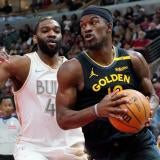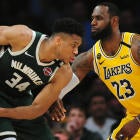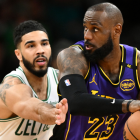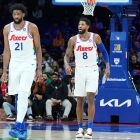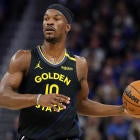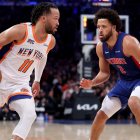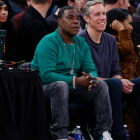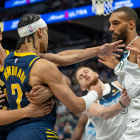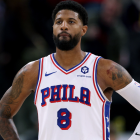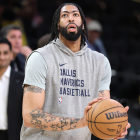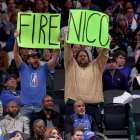LeBron James is still a good defender. By many metrics, he's a great one. He's ranked fourth among all NBA players in ESPN's Defensive Real Plus-Minus and seventh in Pro-Basketball Reference's Defensive Win shares, but such numbers generally favor those who exist within great defensive ecosystems.
For most of the season, that has been the best way to describe LeBron's defense. He's a functioning element of an excellent group, but hardly its driving force. For the most part, he guards weaker opponents and serves as a free safety, calling out coverages and helping or switching when necessary. That role boosts his numbers and creates highlights, but was designed primarily to preserve James for the far heavier load he carries on offense.
He still carried that load in Friday's 113-103 victory over the Milwaukee Bucks, scoring 37 points to go along with eight assists and eight rebounds, but the gravity of the game itself and circumstances within it forced his hand on the other end of the floor. With Giannis Antetokounmpo running roughshod in the first quarter and Anthony Davis quickly falling into foul trouble, James took on the unenviable job of trying to stop the presumptive MVP himself. To his coach, that is what stood out in a marquee win.
"What was more impressive to me was his defense on Giannis," Frank Vogel said. "Starting in the first half when A.D. was in foul trouble, we needed somebody to step up. For him to take on that assignment and still do what he did offensively is just an incredibly remarkable two-way performance… he's a basketball savant."
James didn't need to be pressed into service in what was the Lakers' biggest regular-season game to date. Even with the offense on his back, he volunteered for it knowing that it gave his team its best chance to win.
"He took the matchup," Davis said of LeBron's herculean defensive task, via Silver Screen and Roll. "I mean I had a couple fouls and he only had one, so he told me at the end of the second. It worked for us so we stuck with it and we went on a run, and then down the stretch I went back to guard him, and then he went back to guard him."
Saying that it worked would be an understatement. Giannis scored 10 quick points in the first quarter, but only two in the second once James took over. While he finished with 32 points in the game, only five came in a one-on-one setting against LeBron. He shot 2-for-8 from the field on such attempts, most of which were jump shots. While Antetokounmpo was happy to attack pretty much everybody else, LeBron largely stifled him even on his favorite kinds of shots. Even when driving downhill, Antetokounmpo couldn't overpower James.
Giannis found the same troubles in the post. While he is used to being able to bully mismatches or simply shoot over them, LeBron is so physically gifted and technically sound that he was simply stonewalled whenever he tried to score on James on the low block.
With his usual repertoire limited, Giannis grew increasingly uncomfortable. It showed in his decision-making. While he almost always had a rim-protector looming in the background, by later in the game, it was clear that Giannis had no intention of going after James one-on-one. Without his trademark aggression, Milwaukee's offense struggled.
These issues became so apparent so quickly that the Bucks resorted to the sort of plebian tactics they philosophically disdain. Milwaukee uses the least pick-and-rolls in basketball, but in a desperate bid to get LeBron off of Giannis, the Bucks used Antetokounmpo as both a screener and ball-handler hoping that the Lakers would use a coverage that would alter the matchup calculus. Mike Budenholzer's beautiful motion offense was reduced to James Harden-esque switch-hunting.
There's no shame in switch-hunting. As dull as it can be to watch, it becomes an utterly essential form of offense when pace grinds to a halt in the playoffs. If the Lakers and Bucks meet again in June and James continues to defend this effectively, Milwaukee will go back to it. But doing so damages them more than it would most teams because their scheme is so heavily rhythm-based. The Bucks shooting only 26 percent from behind the arc was no accident. The Lakers disrupted Milwaukee's preferred game flow and forced them into the sort of slugfest that they prefer.
And while some of those switches produced advantageous matchups that Giannis took advantage of, LeBron and his teammates played such good help defense that the strategy's ultimate success was still fairly limited.
That kind of help defense is what James has done best this season, and it is emblematic of the game as a whole. While LeBron took on extra work, he still managed to play the game that he wanted to play. Even with Giannis on his plate, he still created the sort of unscripted chaos that defined his peak defensive play back when he was a member of the Miami Heat.
The team that sets the terms of engagement in a playoff series is usually the one that wins. When these teams first met, the Lakers seemingly had very little control over the kinds of shots that Giannis, and by extension his team, took. In stumbling upon the LeBron matchup on Friday, though, they found a defensive compromise that allowed them to reset the rules under which the game would be played.
Most wings are too small for Giannis. Davis had the length, but not the perimeter comfort or the bulk. James has both. He may not always win in that matchup, but provided he has enough help at the rim, it's one that he proved more than capable of controlling. No team can stop Giannis. Forcing him out of his comfort zone is far more than a consolation prize.
And it's the sort of defensive reward LeBron usually doesn't generate anymore. The Lakers have been satisfied with his complementary play on that end of the floor for most of the season. Against the Bucks, he was their lynchpin on both, and if he can do so again in a potential June rematch, there's a very good chance that he'll add another trophy to his collection.
![[object Object] Logo](https://sportshub.cbsistatic.com/i/2020/04/22/e9ceb731-8b3f-4c60-98fe-090ab66a2997/screen-shot-2020-04-22-at-11-04-56-am.png)





